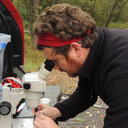Recombinant DNA technology in allergology: cloning and expression of plant profilins.
Atslēgvārdi
Abstrakts
Profilin, an ubiquitous protein involved in eukaryotic cytoskeleton regulation, has been previously described as allergen in grasses, weeds and trees and in many fruits and vegetables, and it is in part responsible for cross-reactivities pollen and food allergic patients. Completed cDNA clones coding for Phleum pratense, Olea europaea, Cynodon dactylon, Parietaria judaica and Helianthus annuus pollen profilins were isolated and sequenced. The deduced amino acid sequences share high identity with other plant profilins. Recombinant profilins were produced in Escherichia coli as non-fusion proteins. Induced cells produced high amounts of recombinant profilin, and after a single purification step on poly-(L-proline)-Sepharose, up to 45 mg of pure allergen per liter culture could be obtained. Recombinant profilins have similar allergenic determinants to their natural counterparts. The tertiary structure of Phleum pratense profilin described here showed three regions important for antibody recognition. The availability of a plant profilin tertiary structure opens future ways on the study of structure/antigenity relationships of these important allergens.


